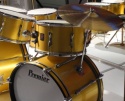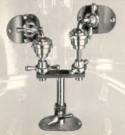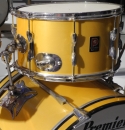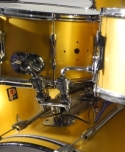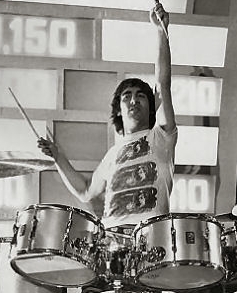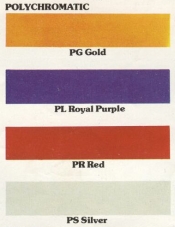You are here:
Keith Moon’s Drumkits: 1974 – Premier Gold kit museum display
About this page
The gold Premier kit (two bass drums, three mounted toms, two floor toms and a snare drum) that was used in the Tommy movie is currently is on display at the Grammy Museum in Los Angeles. It was previously on display at the Guitar Center at the Rock Walk Museum, in Hollywood, California.
Stuart Ritchie, longtime Whotabs site contributor, has contributed the following analysis of the drum setup, including technical specs and details about the kit and its hardware. The Grammy Museum photos are courtesy Lee Harrington.
In addition, Rick Giles has contributed additional information about the original Guitar Center setup.
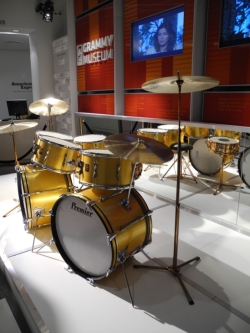
Click to view larger version The kit display at the Grammy Museum in Los Angeles. All museum photos courtesy Lee Harrington.
First of all, I’m very pleased to find out about this exhibit, and I’d like to thank all those who made it possible. It’s rare that the general public has a chance to see any of Keith Moon’s equipment up close. To my knowledge, this is the most complete public exhibit of any of Keith’s drum kits since his final Who concert.
I hope you’ll bear with me as I slog through some exhaustive details. Having assiduously studied perhaps hundreds of photos of Keith’s drums in books, magazines, films and websites (including this one!) since I became a Who fan around 1980 — it appears, to my eye at least, that the exhibit contained a few errors, not only in terms of the way the kit was set up at the exhibit, but also in terms of certain details in the descriptive text included with the exhibit. Since the kit may not be on display anymore, it may be a moot point. Still, I thought I might offer some observations, with all due respect to those who made this unique exhibit possible.
This kit shown at this Grammy Museum exhibit is roughly consistent with the configuration that appears in the Tommy film, so my comments are strictly to do with that configuration of the kit, which essentially duplicates Moon’s black kit from the 1972/early ’73 era in all respects but the plastic finish wrapped over the shell exteriors. In Keith’s concert setup of this period, the gold kit would have included a number of additional pieces that are not included in the exhibit, but are pictured and described elsewhere on the WhoTabs site. These pieces include the four concert toms, mounted in pairs on two Lokfast 318 stands; four Paiste 2002 cymbals on modified Lokfast 314 stands; Paiste hi-hat cymbals mounted on Moon’s specially modified hybrid 314/315 hi-hat stand (sometimes with Rogers Swiv-O-Matic hi-hat clutch); two Paiste symphonic gongs on their gong stands; and one Premier pedal-tuned timpani. In concert, the bass drums would have had their front heads, hoops, and associated tuning rods removed.
Typically, in museum exhibitions, equipment is best presented in as close to working condition as possible, i.e., just as King Henry VIII’s suit of armor is displayed at the Tower Museum in London upon a correctly suited-up mannequin, one might expect that Keith Moon’s drums would be displayed just as they would have been at a Who concert, so that if Keith were alive today, he could easily sit down at the kit and start playing, without having to adjust anything.
Being a drummer myself, I’ve worked with the same type of Rogers Swiv-O-Matic hardware that Moon used for mounting his rack toms to his bass drums. Combining this hands-on experience with an understanding of Moon’s kits, derived from photos and videos of Keith in concert, several things immediately struck me about the exhibit as out of place, which, admittedly, most people probably wouldn’t notice. Lee Harrington, who submitted the photos, has posted a thread on vintagedrumforum.com about this very kit, with very informative responses from other notable contributors, who make similar observations. Evidently, there were at least two, and perhaps as many as four, of these gold kits made, so that some of the gear could go on the road for Who concerts, while duplicates could remain available for the Tommy film.
Firstly, there should not be any cymbals mounted to either of the bass drums. [For the purposes of this discussion, “left” and “right” refer to the drummer’s left and right, i.e., the left bass drum would be the one Keith normally played with his left foot, etc.]
While it’s true that Keith may have mounted a cymbal to his left bass drum in 1966, on his red glitter kit (the first of his double-bass kits), he only did so for a few shows and TV appearances, and afterwards always used regular floor stands for his cymbals. The Swiv-O-Matic 60° collet plate on the upper left of the left bass drum, on all his kits from late 1972 onwards, held a ball-joint tom holder, to provide double bracing for his left-most rack tom. So the left bass drum should have two single Swiv-O-Matic tom holders, one on either side of that one rack tom, so the tom can sit squarely above the “top dead center” of the left bass drum.
Presumably, the original Rogers ball-joint tom holder that would have suspended that side of that rack tom has been lost, misplaced, or moved to a subsequent kit. Why the exhibitor(s) decided to add a cymbal in that position is anyone’s guess.
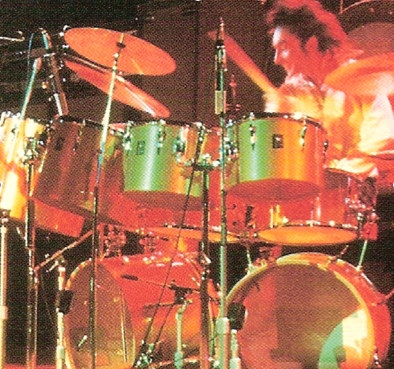
Keith onstage with The Who, Sundown Theatre, Edmonton, north London, December 1973. Note double bracing on left-foot bass drum suspending the 14x8 closed tom. Concert toms also included on floor stands.
While the bass drums are oriented more or less correctly, the exhibit put the toms on the bass drums in the wrong order.
The rack tom shown in the middle position should be swapped with the one shown on the left bass drum. While this may not be obvious at first glance, as the rack toms are all the same size, one can tell because of the position of the tom mounting brackets. See #3 below.
On the right bass drum, this kit would have used double bracing on both of the rack toms. Keith started using this double bracing in late 1972. For the right bass drum, this requires two complete Rogers Swiv-O-Matic 48-2600 dual tom-holder units. Each 48-2600 unit consists of a mounting bracket for fitting to the bass drum shell, an adjustable upright pipe section with a T-bar on top, and two adjustable ball-and-socket joints fitted to the T-bar by collet assemblies.
From each ball joint extends a hexagonal rod, upon which a drum can be fitted by means of a mating collet plate on the tom. Each tom on the right-foot bass drum therefore has two collet-plates: a 90°, and a 60°.
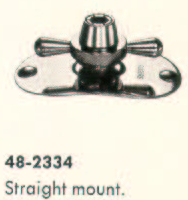
90° straight mount. (Rogers catalog scan courtesy drumarchive.com)
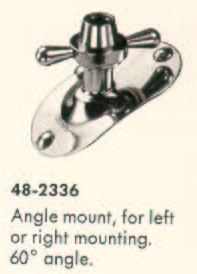
60° angle mount. (Rogers catalog scan courtesy drumarchive.com)
The 90° plates would be oriented on the 48-2600 unit closer to the drummer and bass drum pedal, and the 60° plates would be oriented on the 48-2600 unit facing more toward the audience.
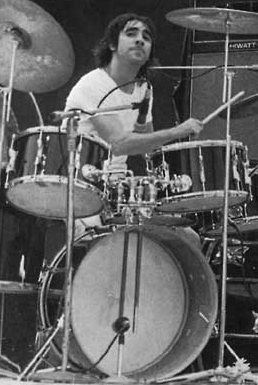
Paris, 1972. Note two Swiv-O-Matic dual tom holders fitted to the right-foot bass drum. This double bracing was also used on subsequent kits including the polychromatic gold kits.
One of the 60° collet plates is shown missing its collet nose, with the collet threads exposed. That drum, while it is oriented correctly toward the audience, should be on the right-foot bass drum, not the left.
One can see clearly in the photos that there is one dual tom-holder assembly present on the right-foot bass drum, but the other is missing.
The original mounting bracket that would have held the missing T-bar has been replaced by one of the collet plates from one of the rack toms. This is evident from the set of five holes visible in the shell of the rack tom farthest to the drummer’s right (audience left).
These exposed holes are exactly those required for attaching the 90° Swiv-O-Matic collet plate, or indeed any Swiv-O-Matic plate.
The result of the misplacement of the toms, and the missing mounting hardware, is that the kit looks a bit lop-sided when compared to shots of Moon actually playing the kit. For example, in the “Pinball Wizard” sequence of the Tommy film, there is a close-up shot of Moon kicking the kit over, that reveals the double tom bracing and the toms in the correct position.
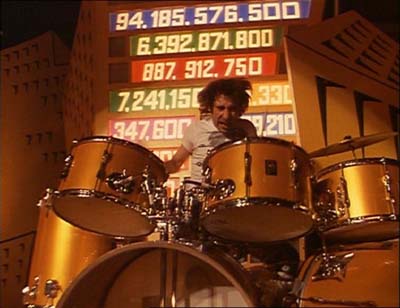
Ca. 1974, filming the Tommy movie, the gold-coloured Premier kit, without the four concert toms.
Production stills from the set of the Tommy film, from the “Pinball Wizard” sequence.
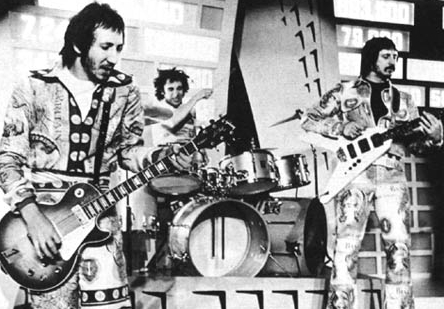
The cymbals shown with this exhibit are clearly not Keith Moon’s cymbals, or most of them aren’t, because they appear to be models not produced until some time after Keith’s untimely death.
These are Paiste’s “Twenty Custom” line of cymbals, first produced in 2011 — see Paiste.
The kit pieces with the copper-plated finish — three cymbal stands, snare drum and snare drum stand — appear to be genuine Keith Moon items, but strictly speaking do not belong with this kit, because they would have been part of the white kit used on The Who’s 1975–76 tour. See #6 below. [Moon was probably using Gretsch snare drums with the gold kit in 1974.]
As for the descriptive text included with the exhibit:
- The first statement is only partially true. “Drummer Keith Moon of The Who used this drum kit to record the band’s seminal 1969 rock opera, Tommy.” While Moon may well have used this kit on the set of the Tommy film, and may have used it to record some of the music on the Tommy film soundtrack, this kit was not built until 1973 at the very earliest, and so could not have appeared on the original 1969 Tommy album.
- The following statement is also only partially true: “Moon requested that the custom-made cymbal stands be gold-plated, but the manufacturer (Rogers) insisted on a more durable copper-plating....” Elsewhere on the WhoTabs site, there is clear evidence to suggest that the copper-plated cymbal stands were manufactured by Premier, not Rogers. On the undersides of these stands’ tripod sections, one should be able to see the words, “PREMIER,” “Lokfast,” and “MADE IN ENGLAND.” [See interview with Mick Double]
And, lastly, if you check the old Premier catalogs, that finish is called, “Polychromatic Gold,” not “Monochromeric Gold.”
If it were me, I would first take all the toms off the kit. Then, I’d remove the 90° collet plate from the right-foot bass drum, and re-install it where it belongs on the (drummer’s) far-right-hand tom. Then, I’d shift the existing dual tom-holder to fit into the top of the custom “iron cross” metal plate.
I’d then re-position the rack toms in the correct position, using only the 90° collet plates to mount them, just as Keith did on numerous kits before he added the dual bracing. The left-hand rack tom could simply be attached to the Swiv-O-Matic single tom holder in its current position on the left-foot bass drum.
Perhaps the correct Rogers Swiv-O-Matic hardware could be acquired on the vintage drum market (eBay, etc.) to replace the missing original parts, though it would make sense to mark such parts as not Keith Moon’s originals, perhaps with an engraving tool... or perhaps by painting them some obviously wrong color, such as fluorescent purple.
Original Guitar Center display
Rick Giles has contributed this additional information about the museum setup of the kit.
A number of years ago around the mid-1990s, I was at the Hollywood Guitar Center store. They had just received the gold Premier kit from Mandy Moon who lived in LA at the time. They were in the process of “restoring” the kit at the time. By the generosity of the store manager, I was allowed to go back to the storage area where the restoration was being done and almost finished. The kit was set up much as you see it now and he let me sit behind the kit on the copper-plated Rogers throne. A dream come true. Being a student of Keith and his kits as well as Rogers drums (which I still play to this day), I noticed as you did the “mistakes” in applying the appropriate hardware. At the time I had acquired an inventory of new old stock Rogers hardware and offered to donate some so that the kit could be put back together correctly. He politely refused and the kit languished in the glass display area of the Hollywood store for years. It would have been so easy to put the kit back together correctly but alas it was not to happen.
Resources and Information
Contributors:
Many thanks to the following, who have made this page possible:
- Stuart Ritchie
- Lee Harrington
- Rick Giles
Return to the main Gold kit page.
